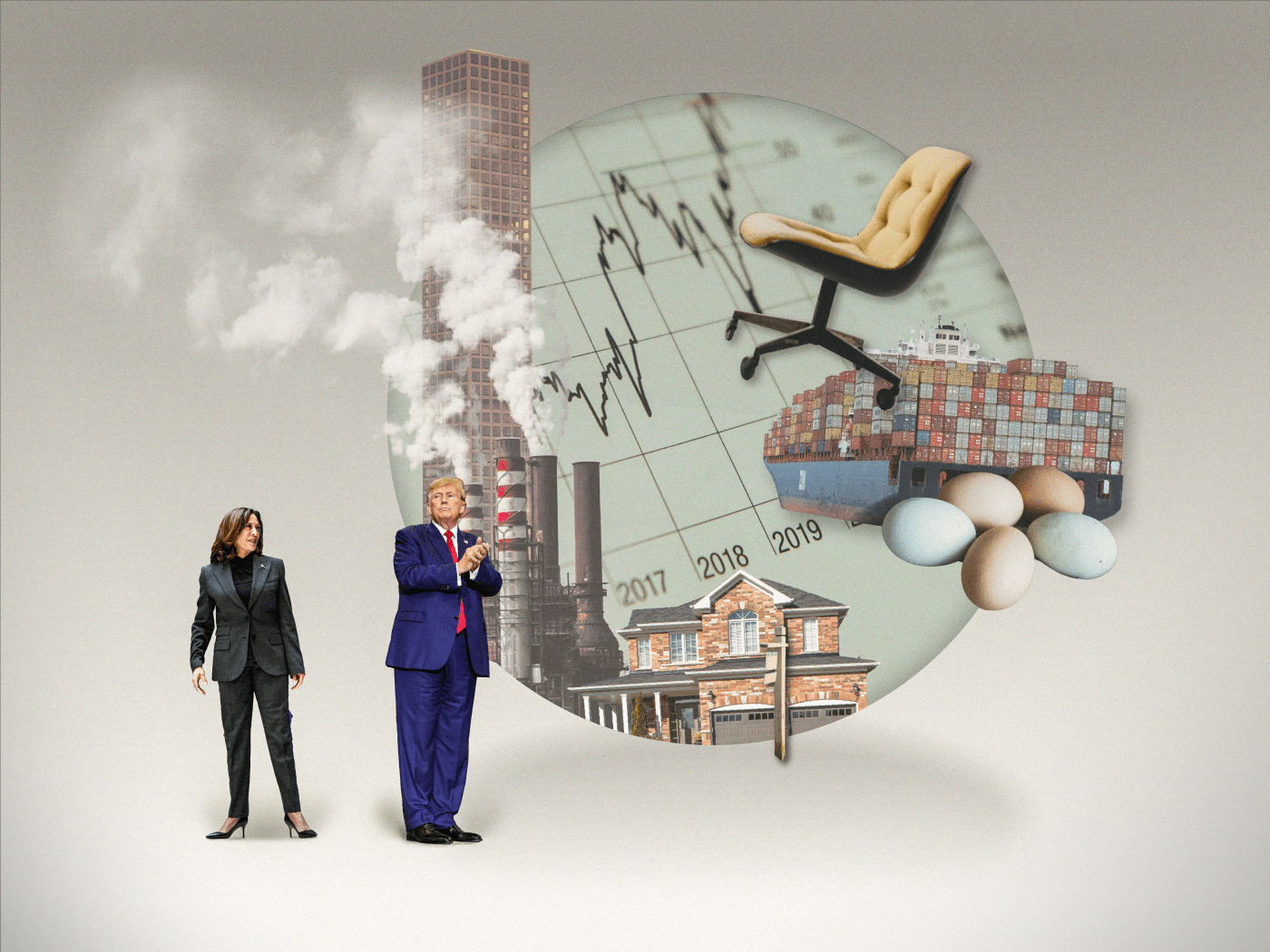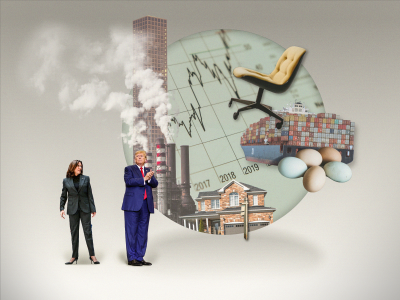Editor’s Note: Although partisans on both sides of the aisle have warned that the stakes of the upcoming presidential election could not be higher, the two campaigns themselves have been remarkably light on policy substance. With Election Day now less than a month away, we reached out to dozens of thinkers, writers, and analysts we trust with a simple question: What are your biggest policy concerns about a potential Trump or Harris administration? We will be publishing their responses—broken up thematically—in the coming days and weeks.
Today’s entry focuses on economic policy, which includes topics ranging from the national debt to trade, from taxation frameworks to monetary policy. The experts we reached out to generally had different concerns about the two major-party candidates’ approaches, but tended to believe both Trump and Harris were prioritizing populist-style pandering over policies that would promote robust and durable economic growth.
Proposed crackdowns on immigration would inhibit economic growth.
Immigration is the most important economic issue facing the United States. Without immigrants, the country’s workforce would be shrinking month-over-month, resulting in a diminishment in global power and prestige. But immigrants shouldn’t just be viewed as labor inputs—they bring ideas for new products, as well as the entrepreneurial zeal to set up new businesses ranging from dry cleaners to high-tech firms.
Right now, the United States has what seems like the worst of all worlds situation: an overly restrictive and poorly designed set of laws limiting immigration—that are dramatically underenforced. The result is missed economic opportunity, with millions of people in the country facing tremendous insecurity and a class of laborers who can undercut American workers by working for below minimum wage and skirting other labor laws.
Kamala Harris would do a better job enforcing immigration law in the next four years than the Biden administration has in the last four, if anything because of the political blowback that such lax enforcement has engendered. She will not, however, be able to change the overly restrictive and poorly designed set of laws themselves.
Donald Trump will do even more to enforce the law, potentially in a cruel and inhumane way that goes beyond what the law requires. At the same time, he has not made any formal proposals to expand immigration and, as president, supported the RAISE Act, which would have cut the number of green cards issued annually in half. This would make us look back nostalgically on the current system.
The economy grew at a 3 percent annual rate during the Trump administration before the COVID-19 pandemic, and key economic advisers to candidate Trump are suggesting that he set a repeat of this as his goal if he returns to the White House. During his first term, however, that growth was fueled by a large drop in the unemployment rate from its still elevated post-crisis levels in 2016. With the economy now close to full employment, that source of growth is absent today and Trump’s immigration plans would make it extremely difficult for him to even achieve 2 percent annual growth. It is possible that an increased labor-force participation rate could boost economic growth, but it is already relatively high, an aging population is pushing it down, and there is no credible evidence that immigration restrictions would have any effect on it.
In the longer run, making the country less hospitable to immigrants—through new laws, enforcement of existing laws, and a less welcoming tone—will undermine our ability to be the type of country that gave birth to companies like Alphabet (formerly Google), AT&T, and Pfizer. No amount of the deregulation and tax cuts Trump is proposing will be able to undo that harm.
—Jason Furman, economics professor at Harvard University and non-resident senior fellow at the Peterson Institute for International Economics
Americans are choosing between an absurd tax framework and chaotic efforts to tamper with monetary policy.
Donald Trump recently told reporters that, as president, he would seek control over the monetary policy decisions currently under the jurisdiction of the Federal Reserve. While no details have been provided, Trump added, “I feel the president should have at least [a] say in there. ... I think I have a better instinct than, in many cases, people that would be on the Federal Reserve or the chairman.” Previous comments by the former president suggest he has strong disagreements with Federal Reserve Chairman Jerome Powell (who Trump himself reappointed in 2018) and a desire for lower interest rates.
When it comes to Trump, it’s often unclear whether he should be taken seriously or treated as if he is just blowing off steam. However, Trump allies (unaffiliated with the campaign) have drafted plans to transfer monetary policy authority to the White House. Thankfully, current law gives the president little authority to seize the monetary policy controls. The Fed’s board of governors consists of seven members appointed by the president for staggered 14-year terms, leaving Trump without the authority to replace the full group in one term. Nor can Trump replace the presidents of the regional Fed banks, who also rotate onto the rate-setting Federal Open Market Committee. Powell’s term as chairman ends in May 2026, at which point Trump can appoint a new chairperson subject to Senate confirmation. Any structural reforms to the Fed would require an extremely unlikely act of Congress.
While presidents have often publicly lobbied the Fed for lower interest rates (sometimes successfully), formally demanding a White House role in setting monetary policy would be extraordinarily destructive. The vast majority of nations with advanced economies maintain independent central banks, because political influence would inevitably pander to popular demands for low interest rates that—in the short-term—aid borrowers, goose economic growth, and lower the financing cost of the national debt. Over time, however, the resulting inflation (and inflation expectations) would harm families and destabilize the economy. Financial markets would recoil at the unpredictability of monetary policy shifting on presidential moods and political fortunes rather than economic fundamentals. The result would be economic chaos, steep inflation, and eventually recession (or worse). Given Trump’s stated desire to rein in inflation, it would be wiser to let the Federal Reserve do the unpopular dirty work of tightening monetary policy when necessary, and then take credit for the stronger, lower-inflation economy that such actions produce.
Kamala Harris’ tax agenda, meanwhile, is based on an economically absurd and mathematically impossible framework. With budget deficits projected to leap toward $4 trillion a decade from now, Harris is attempting to maintain rising spending, significantly cut taxes for 95 percent of families, and still keep the deficit at manageable levels—all by imposing historic new taxes on corporations and the highest-earning 5 percent of families.
According to data from the Organization for Economic Cooperation and Development (OECD), the United States already has the most progressive federal tax system of all 38 OECD nations. America’s top marginal tax rates for income, capital gains, corporate, and estate taxes each exceed OECD averages, while the U.S. taxes middle- and low-income families at dramatically lower rates than our international competitors. Harris’ proposed increases would, when coupled with state taxes, raise America’s corporate tax rate to the second-highest level in the OECD, with total corporate tax revenues jumping from current levels by up to 50 percent. Capital gains tax rates (including surtaxes and state taxes) would exceed 45 percent in some states—dwarfing even tax-drenched Scandinavian nations and likely reducing revenues from current levels. The U.S. would even begin taxing theoretical income—in the form of unrealized capital gains—for the highest earners. Again, even most European nations do not go this far.
Yet rather than put this additional revenue toward deficit reduction, Harris would plow this money into extending the 2017 tax cuts for the bottom-earning 95 percent of families, expanding the child tax credit, cutting taxes for small businesses, subsidizing home ownership, and mimicking Trump’s inane proposal to exempt tips from taxation. Collectively, these reforms would ensure that the bottom-earning 60 percent of families collectively pay no income taxes, while corporations and the top-earning 5 percent of families would be tasked with financing nearly the entire free-spending federal government. While such populism is surely politically popular, even Europe eventually discovered that such an extremely top-heavy tax system is unsustainable. There are not enough wealthy corporations and families to finance all of the spending, and such exorbitant tax rates starve an economy of investment, limit productivity, drive capital abroad, and ultimately kill wages and jobs.
Unsurprisingly, the Tax Foundation found that Harris’ tax plan would shave 2 percent off the long-term gross domestic product, reduce wages by 1.2 percent, and wipe out nearly 800,000 jobs. And after accounting for revenue lost to economic damage as well as to middle- and lower-income tax cuts, the plan may ultimately lose revenue, allowing deficits to rise further. Hopefully, a Harris presidency would be paired by a sane Congress putting the brakes on this destructive tax vision.
—Brian Riedl, senior fellow, Manhattan Institute
Harris’ tax plans would reduce long-term prosperity. Trump’s proposals might be even worse.
Donald Trump has promised to lead the “largest deportation” effort in U.S. history if voters return him to the White House in November, and his advisers are reportedly hard at work drawing up plans to execute this goal. But an abrupt and intrusive effort to deport hundreds of thousands (or even millions) of undocumented immigrants would significantly disrupt businesses. The labor shortages it would create would put upward pressure on the prices of many goods and services—fresh produce, hotel rooms, restaurant meals, etc.—and could potentially spark an inflationary wage-price spiral that the Federal Reserve would have to stop, putting at risk the longevity of the current economic expansion.
The long-term consequences of Trump’s posture toward immigration could be even more damaging. The former president has consistently demonized immigrants, even declaring in recent months that they are “poisoning the blood of our country.” Trump is effectively hanging an “immigrants need not apply” sign on the Statue of Liberty. But diminishing America’s status as the destination of choice for many of the hardest working, most risk-tolerant, and most ambitious foreign-born people in the world is an act of significant economic self-sabotage.
By attacking the integrity of elections and international alliances, Trump chips away at the foundations of long-term prosperity. This is of heightened concern following the events of January 6, of course, and also because the next president will take office with land wars raging in Europe and the Middle East, as well as growing geopolitical tensions in East Asia.
Vice President Kamala Harris’ desire to increase taxes on corporations and investment—through higher taxes on businesses and capital income—would reduce long-term prosperity by reducing productivity and income growth.
And both Trump and Harris are uninterested in reducing projected spending on Medicare and Social Security. Because those programs are largely responsible for the nation’s disastrous fiscal outlook and exploding national debt, the bipartisan consensus in favor of the status quo invites a damaging bond-market event and the sudden, suboptimal restructuring of those programs. In the meantime, large structural deficits chip away at private investment and reduce workers’ wages by lowering productivity growth. They also remove the political space to make investments in economic growth and opportunity.
—Michael Strain, director of economic policy studies, American Enterprise Institute
Hostility to free trade should worry American investors, consumers, and allies alike.
Congress has delegated vast swaths of its constitutional authority over tariff policy to the executive branch via several different laws, some of which have never even been used. Presidents largely avoided abusing these ambiguous and discretionary pieces of legislation for more than 80 years, but this has changed dramatically over the past decade, with both Presidents Donald Trump and Joe Biden implementing broad tariffs, supposedly to boost domestic industry, protect “national security,” or combat “unfair trade.” Congress, the courts, and the World Trade Organization proved unable—or unwilling—to limit or reverse these actions. Americans have paid a steep price in the process, but almost all the tariffs remain—and now Trump is threatening to implement even more.
The Supreme Court’s recent decision in Loper Bright Enterprises v. Raimondo opens the door to more robust judicial checks on the future use and abuse of unilateral tariff authorities by Trump, Kamala Harris, or anyone else. But a wholesale, judicially enforced rebalancing is uncertain if not unlikely, particularly with respect to authorities invoked in the name of “national security” or during a presidentially declared “national emergency.”
The only sure way to limit the risk of future unilateral tariff increases like the ones Trump is now promising, therefore, is for Congress acting to reclaim some of its constitutional trade powers—or, at the very least, to more tightly circumscribe the conditions under which a president may use tariffs without express congressional approval. If recent history is any guide, however, near-term legislative reforms will prove difficult, if not impossible—especially before next year.
If that’s indeed the case, additional U.S. tariffs—and the resulting economic and geopolitical damage—simply cannot be ruled out. And everyone—investors, allied governments, American consumers, etc.—should be more worried about this possibility than they seemingly are today.
—Scott Lincicome, vice president of general economics, Cato Institute
Neither candidate seems to be prioritizing incentives for business investment.
Donald Trump and Kamala Harris both have very bad ideas on taxes. Trump’s worst tax policy ideas—his tariffs—are perhaps doubly concerning thanks to the possibility of unilateral executive action. However, my biggest concern is not any new policy being enacted. It’s some old policies not being renewed.
The 2017 Tax Cuts and Jobs Act (TCJA) made numerous changes, but I want to highlight two. First, it temporarily introduced 100 percent bonus depreciation for short-lived assets, letting companies fully deduct the cost of equipment and machinery. Bonus depreciation started phasing out in 2023. The TCJA also introduced research and development (R&D) amortization starting in 2022. R&D amortization requires companies to spread deductions for R&D costs out over five years for domestic R&D and 15 years for international R&D. The 100 percent bonus depreciation temporarily eliminated a tax bias against investment, while R&D amortization introduced a new one.
Reversing R&D amortization and restoring 100 percent bonus depreciation fit with economic themes both Trump and Harris have hit on the campaign trail about investing in America and supporting cutting-edge industry, but those two specific policies themselves haven’t been a focus. Instead, the two candidates have attempted to outdo one another with narrowly targeted tax cuts. Trump came out with no tax on tips, Harris followed suit, and then Trump proposed no tax on overtime pay. The Harris campaign has endorsed tax credits for various kinds of investment (in certain advanced technology and legacy technology industries, with extra tax breaks related to unionization and investment location), but her announced policies largely ignore economy-wide reforms.
The ball is in Congress’ court for the Tax Cuts and Jobs Act expiration, but presidential input matters. Either candidate could push for pro-investment provisions to be made priorities, but without direction, Congress could pursue an “extender”-style solution. When major tax provisions are scheduled to expire, Congress sometimes extends the provisions for only a year or two—for instance, the Bush tax cuts were extended for two years in 2010. A temporary extension might put some money back in voters’ pockets, but it does not really improve investment incentives, as companies value policy stability.
In an episode of Parks and Recreation, Ron Swanson tells Leslie Knope, “Never half-ass two things. Whole-ass one thing.” I worry the pile of new, strange ideas coming out this campaign season is an omen of a “half-ass two things” approach to the TCJA expirations, which is exactly what a temporary extension with no long-term fix to the tax treatment of R&D and equipment would represent.
—Alex Muresianu, senior policy analyst, Tax Foundation
A Harris win could bring Build Back Better-style entitlements back from the dead.
The 2024 presidential election is about bad and also bad options. There are significant downside risks all around.
With Vice President Kamala Harris, a major concern is that a solid win might deliver a Democratic Congress and, therefore, a second chance to pass a Build Back Better-like budget plan. The result would be a significant expansion of permanent entitlement benefits paid for with unpopular taxes that could get scaled back later.
Build Back Better (BBB) was President Joe Biden’s top domestic priority, and would be law today if not for opposition in 2021 and 2022 from Democratic Sens. Joe Manchin and Kyrsten Sinema, neither of whom will be in Congress come January. In 2022, the Biden administration negotiated a smaller bill with Manchin—the “Inflation Reduction Act”—that focused on combating climate change with clean energy subsidies and reforming Medicare’s drug coverage.
In 2025, a Democratic Senate majority may not block a bill resembling the original BBB. The House-passed version of what the Biden administration recommended was expected to cost $2.4 trillion over 10 years while containing offsets totaling about $2.3 trillion over the same period. That version sought to expand Medicaid home health coverage and provide universal preschool assistance. It also would have expanded Medicare benefits and created additional entitlements related to higher education, housing, and family and medical leave.
Like former President Donald Trump, Harris is not emphasizing fiscal discipline in her campaign. The energy within her party remains around expanding government assistance for a growing list of circumstances. While some of the initiatives that Harris is currently championing may have merit, they would add to a federal budget that is already overflowing with spending commitments that the government has no clear path to pay for in the coming years.
In other words, a Harris win, if it comes with Democratic control of Congress, would likely intensify the forces that are pushing federal debt up to record levels.
—James Capretta, senior fellow, American Enterprise Institute






Please note that we at The Dispatch hold ourselves, our work, and our commenters to a higher standard than other places on the internet. We welcome comments that foster genuine debate or discussion—including comments critical of us or our work—but responses that include ad hominem attacks on fellow Dispatch members or are intended to stoke fear and anger may be moderated.
With your membership, you only have the ability to comment on The Morning Dispatch articles. Consider upgrading to join the conversation everywhere.